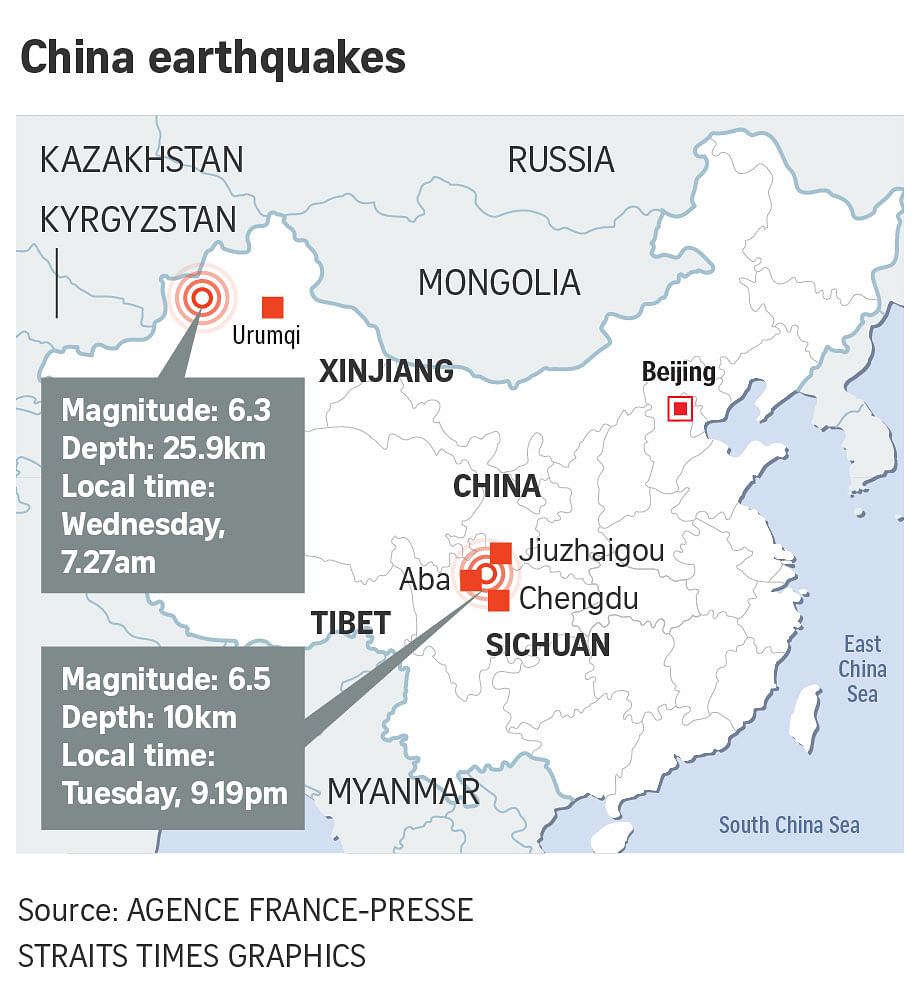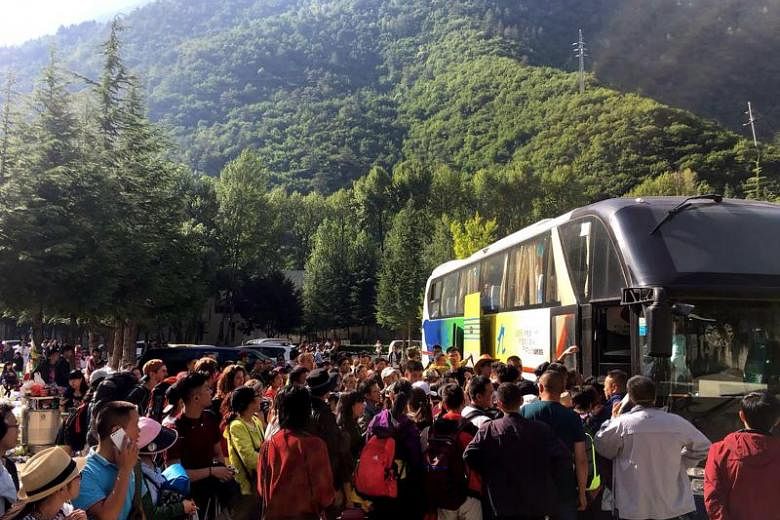BEIJING (AFP, REUTERS) - China on Wednesday (Aug 9) evacuated nearly 60,000 people in its mountainous south-west after a strong earthquake killed at least 19 people, rattling a region where memories of a 2008 seismic disaster remain fresh.
The 7.0-magnitude earthquake struck Sichuan province late on Tuesday, tearing cracks in mountain highways, triggering landslides, damaging buildings and sending panicked residents and tourists fleeing into the open.
The provincial government said Wednesday afternoon that most of the tourists - many stranded at a popular national park near the epicentre - have been evacuated after spending a nervous night out in the open as more than 1,000 aftershocks rippled across the region.
Locals will also be moved to safer ground, according to the authorities.
The area's difficult geography - and travel restrictions quickly imposed by authorities - have so far prevented a clear picture of the scale of the disaster from emerging, but there were no reports of catastrophic damage or large-scale casualties by Wednesday afternoon.
The quake killed at least 19 people, including eight tourists, and injured at least 247, 40 of them seriously, according to the local government of Aba prefecture where the epicentre was located. Two foreign nationals, a French man and a Canadian woman, are among the injured.
Images on social media or in state news outlets showed cars and buses tossed into ravines or crushed by giant boulders jolted loose from surrounding hills, and rescue personnel combing through rubble for any victims.
Aerial footage broadcast by state-run Xinhua news agency showed picturesque green-forested mountains now scarred by huge gouges from giant landslides that sent clouds of dust into the air.
A reception area in a hotel had collapsed, trapping some people, but 2,800 people had been evacuated from the building safely, the Sichuan fire service said.

Sichuan is frequently struck by tremors. A huge quake there in May 2008 killed almost 70,000 people.
A separate quake with a magnitude of 6.6 struck a remote part of China's far north-western region of Xinjiang, more than 2,000 km (1,240 miles) away, on Wednesday morning, the Chinese earthquake administration said. The People's Daily said 32 people had been injured in the mostly rural area.
A French man and a Canadian woman were among those injured in Sichuan. Mr Maxence Vallon, 18, was wounded in both legs, while the Canadian woman, who declined to be named, suffered slight injury in the head, Xinhua news agency reported.
Both are being treated at the People's Hospital of Jiuzhaigou county.
"We were lying on an open ground to seek shelter when a big stone fell and hit my brother right in the leg," said Mr Romain Vallon, who studies in Beijing. The brothers were staying in a hotel with their mother in Jiuzhaigou when the quake happened, according to Xinhua.
The Sichuan earthquake administration, which also measured the quake at a magnitude of 7.0, said the epicentre of the tremor was in Ngawa prefecture, which is largely populated by ethnic Tibetans, many of whom are nomadic herders.
The area was rattled by a number of aftershocks on Wednesday.
Pictures on state-run social media sites showed some damage in Jiuzhaigou, with tiles having fallen from buildings and people gathering outdoors.
State television said electricity had now largely been restored to the affected areas and the military was also sending rescuers to help with relief efforts. Jiuzhaigou airport was operating as normal after the runway was checked for damage, the report said.
The Sichuan government said on one of its official social media sites that more than 38,000 tourists were currently visiting Jiuzhaigou.
Shaking was felt in the provincial capital, Chengdu, and as far away as Xi'an, home of the famous terracotta warrior figures, according to users of Chinese social media.
Sichuan is frequently struck by earthquakes. A quake there in May 2008 killed almost 70,000 people.
The Xinjiang quake's epicentre was in Jinghe county, about 100km from the border with Kazakhstan, where about 140,000 people live, according to Xinhua.
Residents several hundred kilometres away in Urumqi, and the cities of Karamay and Yining, felt strong tremors, Xinhua said. The jolt lasted about 20 seconds, it said.
Aftershocks also shook Xinjiang on Wednesday.





